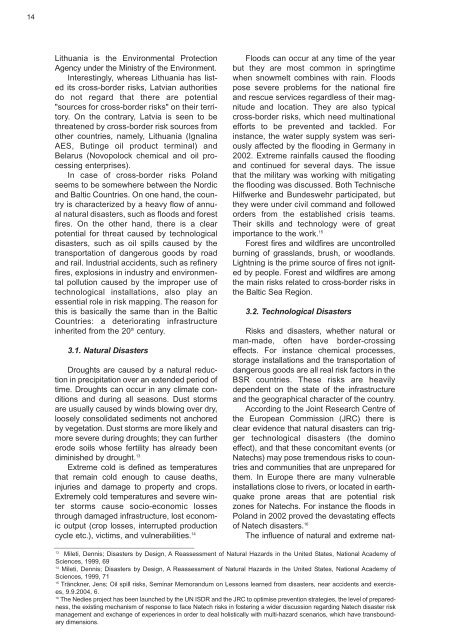Cross-Border Risks in the Baltic Sea Region: Lessons to ... - Helsinki.fi
Cross-Border Risks in the Baltic Sea Region: Lessons to ... - Helsinki.fi
Cross-Border Risks in the Baltic Sea Region: Lessons to ... - Helsinki.fi
Create successful ePaper yourself
Turn your PDF publications into a flip-book with our unique Google optimized e-Paper software.
14<br />
Lithuania is <strong>the</strong> Environmental Protection<br />
Agency under <strong>the</strong> M<strong>in</strong>istry of <strong>the</strong> Environment.<br />
Interest<strong>in</strong>gly, whereas Lithuania has listed<br />
its cross-border risks, Latvian authorities<br />
do not regard that <strong>the</strong>re are potential<br />
"sources for cross-border risks" on <strong>the</strong>ir terri<strong>to</strong>ry.<br />
On <strong>the</strong> contrary, Latvia is seen <strong>to</strong> be<br />
threatened by cross-border risk sources from<br />
o<strong>the</strong>r countries, namely, Lithuania (Ignal<strong>in</strong>a<br />
AES, But<strong>in</strong>ge oil product term<strong>in</strong>al) and<br />
Belarus (Novopolock chemical and oil process<strong>in</strong>g<br />
enterprises).<br />
In case of cross-border risks Poland<br />
seems <strong>to</strong> be somewhere between <strong>the</strong> Nordic<br />
and <strong>Baltic</strong> Countries. On one hand, <strong>the</strong> country<br />
is characterized by a heavy flow of annual<br />
natural disasters, such as floods and forest<br />
<strong>fi</strong>res. On <strong>the</strong> o<strong>the</strong>r hand, <strong>the</strong>re is a clear<br />
potential for threat caused by technological<br />
disasters, such as oil spills caused by <strong>the</strong><br />
transportation of dangerous goods by road<br />
and rail. Industrial accidents, such as ref<strong>in</strong>ery<br />
<strong>fi</strong>res, explosions <strong>in</strong> <strong>in</strong>dustry and environmental<br />
pollution caused by <strong>the</strong> improper use of<br />
technological <strong>in</strong>stallations, also play an<br />
essential role <strong>in</strong> risk mapp<strong>in</strong>g. The reason for<br />
this is basically <strong>the</strong> same than <strong>in</strong> <strong>the</strong> <strong>Baltic</strong><br />
Countries: a deteriorat<strong>in</strong>g <strong>in</strong>frastructure<br />
<strong>in</strong>herited from <strong>the</strong> 20 th century.<br />
3.1. Natural Disasters<br />
Droughts are caused by a natural reduction<br />
<strong>in</strong> precipitation over an extended period of<br />
time. Droughts can occur <strong>in</strong> any climate conditions<br />
and dur<strong>in</strong>g all seasons. Dust s<strong>to</strong>rms<br />
are usually caused by w<strong>in</strong>ds blow<strong>in</strong>g over dry,<br />
loosely consolidated sediments not anchored<br />
by vegetation. Dust s<strong>to</strong>rms are more likely and<br />
more severe dur<strong>in</strong>g droughts; <strong>the</strong>y can fur<strong>the</strong>r<br />
erode soils whose fertility has already been<br />
dim<strong>in</strong>ished by drought. 13<br />
Extreme cold is def<strong>in</strong>ed as temperatures<br />
that rema<strong>in</strong> cold enough <strong>to</strong> cause deaths,<br />
<strong>in</strong>juries and damage <strong>to</strong> property and crops.<br />
Extremely cold temperatures and severe w<strong>in</strong>ter<br />
s<strong>to</strong>rms cause socio-economic losses<br />
through damaged <strong>in</strong>frastructure, lost economic<br />
output (crop losses, <strong>in</strong>terrupted production<br />
cycle etc.), victims, and vulnerabilities. 14<br />
Floods can occur at any time of <strong>the</strong> year<br />
but <strong>the</strong>y are most common <strong>in</strong> spr<strong>in</strong>gtime<br />
when snowmelt comb<strong>in</strong>es with ra<strong>in</strong>. Floods<br />
pose severe problems for <strong>the</strong> national <strong>fi</strong>re<br />
and rescue services regardless of <strong>the</strong>ir magnitude<br />
and location. They are also typical<br />
cross-border risks, which need mult<strong>in</strong>ational<br />
efforts <strong>to</strong> be prevented and tackled. For<br />
<strong>in</strong>stance, <strong>the</strong> water supply system was seriously<br />
affected by <strong>the</strong> flood<strong>in</strong>g <strong>in</strong> Germany <strong>in</strong><br />
2002. Extreme ra<strong>in</strong>falls caused <strong>the</strong> flood<strong>in</strong>g<br />
and cont<strong>in</strong>ued for several days. The issue<br />
that <strong>the</strong> military was work<strong>in</strong>g with mitigat<strong>in</strong>g<br />
<strong>the</strong> flood<strong>in</strong>g was discussed. Both Technische<br />
Hilfwerke and Bundeswehr participated, but<br />
<strong>the</strong>y were under civil command and followed<br />
orders from <strong>the</strong> established crisis teams.<br />
Their skills and technology were of great<br />
importance <strong>to</strong> <strong>the</strong> work. 15<br />
Forest <strong>fi</strong>res and wild<strong>fi</strong>res are uncontrolled<br />
burn<strong>in</strong>g of grasslands, brush, or woodlands.<br />
Lightn<strong>in</strong>g is <strong>the</strong> prime source of <strong>fi</strong>res not ignited<br />
by people. Forest and wild<strong>fi</strong>res are among<br />
<strong>the</strong> ma<strong>in</strong> risks related <strong>to</strong> cross-border risks <strong>in</strong><br />
<strong>the</strong> <strong>Baltic</strong> <strong>Sea</strong> <strong>Region</strong>.<br />
3.2. Technological Disasters<br />
<strong>Risks</strong> and disasters, whe<strong>the</strong>r natural or<br />
man-made, often have border-cross<strong>in</strong>g<br />
effects. For <strong>in</strong>stance chemical processes,<br />
s<strong>to</strong>rage <strong>in</strong>stallations and <strong>the</strong> transportation of<br />
dangerous goods are all real risk fac<strong>to</strong>rs <strong>in</strong> <strong>the</strong><br />
BSR countries. These risks are heavily<br />
dependent on <strong>the</strong> state of <strong>the</strong> <strong>in</strong>frastructure<br />
and <strong>the</strong> geographical character of <strong>the</strong> country.<br />
Accord<strong>in</strong>g <strong>to</strong> <strong>the</strong> Jo<strong>in</strong>t Research Centre of<br />
<strong>the</strong> European Commission (JRC) <strong>the</strong>re is<br />
clear evidence that natural disasters can trigger<br />
technological disasters (<strong>the</strong> dom<strong>in</strong>o<br />
effect), and that <strong>the</strong>se concomitant events (or<br />
Natechs) may pose tremendous risks <strong>to</strong> countries<br />
and communities that are unprepared for<br />
<strong>the</strong>m. In Europe <strong>the</strong>re are many vulnerable<br />
<strong>in</strong>stallations close <strong>to</strong> rivers, or located <strong>in</strong> earthquake<br />
prone areas that are potential risk<br />
zones for Natechs. For <strong>in</strong>stance <strong>the</strong> floods <strong>in</strong><br />
Poland <strong>in</strong> 2002 proved <strong>the</strong> devastat<strong>in</strong>g effects<br />
of Natech disasters. 16<br />
The <strong>in</strong>fluence of natural and extreme nat-<br />
13<br />
Mileti, Dennis; Disasters by Design, A Reassessment of Natural Hazards <strong>in</strong> <strong>the</strong> United States, National Academy of<br />
Sciences, 1999, 69<br />
14<br />
Mileti, Dennis; Disasters by Design, A Reassessment of Natural Hazards <strong>in</strong> <strong>the</strong> United States, National Academy of<br />
Sciences, 1999, 71<br />
15<br />
Tränckner, Jens; Oil spill risks, Sem<strong>in</strong>ar Memorandum on <strong>Lessons</strong> learned from disasters, near accidents and exercises,<br />
9.9.2004, 6.<br />
16<br />
The Nedies project has been launched by <strong>the</strong> UN ISDR and <strong>the</strong> JRC <strong>to</strong> optimise prevention strategies, <strong>the</strong> level of preparedness,<br />
<strong>the</strong> exist<strong>in</strong>g mechanism of response <strong>to</strong> face Natech risks <strong>in</strong> foster<strong>in</strong>g a wider discussion regard<strong>in</strong>g Natech disaster risk<br />
management and exchange of experiences <strong>in</strong> order <strong>to</strong> deal holistically with multi-hazard scenarios, which have transboundary<br />
dimensions.
















